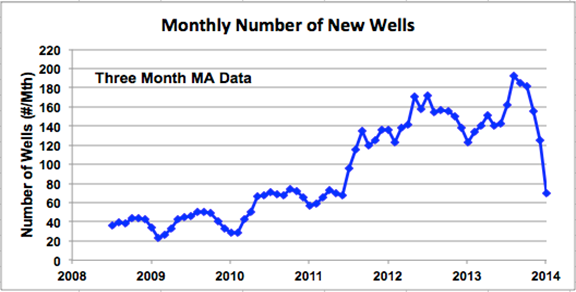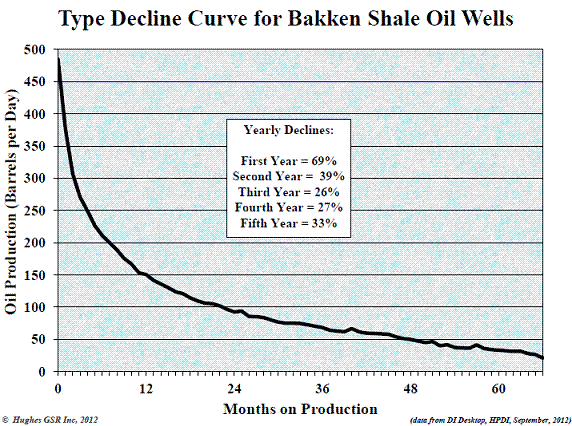Oil plummets, but why did it take so long?
http://peakoilbarrel.com/wp-content/uploads/2014/02/AAA-Ovi15.png
Notice the timing on that big leg down? It started in the summer of 2013. It took almost a full year for the price of crude oil to begin to mirror that large decline in the number of new wells in the Bakken. Not a very efficient market, eh? Oil should have starting selling off a lot sooner than summer of 2014. This move in oil has been telegraphed for a long time. Everyone either already knows that shale is a pyramid or ponzi scheme, or they are quickly learning. It is a pyramid scheme because those pretty graphs of production from exponentially increasing new wells are used to make it look as if production will continue to increase even when the number of new wells stops going parabolic. But no, that's just a scam to lure investors. As soon as the number of new wells stops increasing, oil production stops increasing and begins to decline, after about a 1-2 year delay.
http://econbrowser.com/wp-content/uploads/2012/12/hughes_oil3.gif
Yes, that is a 69% annual decline after one year. That is the typical decline rate for the typical horizontally fractured shale well. It sounds incredible, but this is a well known number. It is not like this number is a revelation to anyone who has studied shale oil.
The problem is that we have millions of people frantically seeking yield on billions of dollars of investments in this sector. You can thank the Federal Reserve for that, but that is beside the point. The point is that these people, who know nothing about shale, yet have still been willing to put their money into it, probably have been having a change of heart as they learn how fast these wells decline. Think about it. How can you base 10 year debt on wells that basically only last 2 years. Sure they still produce oil after two years, but come on, 80% of the oil is already gone but only 20% of the debt will have been serviced. It doesn't take a genius to realize that is a scam. The junk debt in this sector is doomed, and there is more than a trillion dollars of it. That is most likely why oil is crashing now.Some time this summer, we reached a 100th monkey moment. Oil has been selling off ever since.
But wait, shouldn't the price of oil rise if shale production is about to plateau and then inevitably decline? In a normal, rational world, it might. But in a world flooded by Fed funny money all bets are off. It is hard for the market to price this dynamic when you have half a trillion in losses looming over this sector. This is going to hurt the economy very badly, since this sector has been the only real source of good jobs in America in this decade.
There will be upward pressure on the price of oil when shale production begins to fall off. But not as much as you would think, because most of the market is just going to assume that the declining production would have been caused by the turmoil occurring right now. It would be erroneous to believe that any decline in shale output is to be blamed on the recent declines in oil price, but I am certain that is how the media will present it. Keep in mind that the graph above clearly shows that the rate of growth in new wells fell off a long long time before oil prices began their cliff dive. It is an interesting chicken vs egg scenario that we should all keep in mind.
Notice the timing on that big leg down? It started in the summer of 2013. It took almost a full year for the price of crude oil to begin to mirror that large decline in the number of new wells in the Bakken. Not a very efficient market, eh? Oil should have starting selling off a lot sooner than summer of 2014. This move in oil has been telegraphed for a long time. Everyone either already knows that shale is a pyramid or ponzi scheme, or they are quickly learning. It is a pyramid scheme because those pretty graphs of production from exponentially increasing new wells are used to make it look as if production will continue to increase even when the number of new wells stops going parabolic. But no, that's just a scam to lure investors. As soon as the number of new wells stops increasing, oil production stops increasing and begins to decline, after about a 1-2 year delay.
http://econbrowser.com/wp-content/uploads/2012/12/hughes_oil3.gif
Yes, that is a 69% annual decline after one year. That is the typical decline rate for the typical horizontally fractured shale well. It sounds incredible, but this is a well known number. It is not like this number is a revelation to anyone who has studied shale oil.
The problem is that we have millions of people frantically seeking yield on billions of dollars of investments in this sector. You can thank the Federal Reserve for that, but that is beside the point. The point is that these people, who know nothing about shale, yet have still been willing to put their money into it, probably have been having a change of heart as they learn how fast these wells decline. Think about it. How can you base 10 year debt on wells that basically only last 2 years. Sure they still produce oil after two years, but come on, 80% of the oil is already gone but only 20% of the debt will have been serviced. It doesn't take a genius to realize that is a scam. The junk debt in this sector is doomed, and there is more than a trillion dollars of it. That is most likely why oil is crashing now.Some time this summer, we reached a 100th monkey moment. Oil has been selling off ever since.
But wait, shouldn't the price of oil rise if shale production is about to plateau and then inevitably decline? In a normal, rational world, it might. But in a world flooded by Fed funny money all bets are off. It is hard for the market to price this dynamic when you have half a trillion in losses looming over this sector. This is going to hurt the economy very badly, since this sector has been the only real source of good jobs in America in this decade.
There will be upward pressure on the price of oil when shale production begins to fall off. But not as much as you would think, because most of the market is just going to assume that the declining production would have been caused by the turmoil occurring right now. It would be erroneous to believe that any decline in shale output is to be blamed on the recent declines in oil price, but I am certain that is how the media will present it. Keep in mind that the graph above clearly shows that the rate of growth in new wells fell off a long long time before oil prices began their cliff dive. It is an interesting chicken vs egg scenario that we should all keep in mind.



0 Comments:
Post a Comment
<< Home